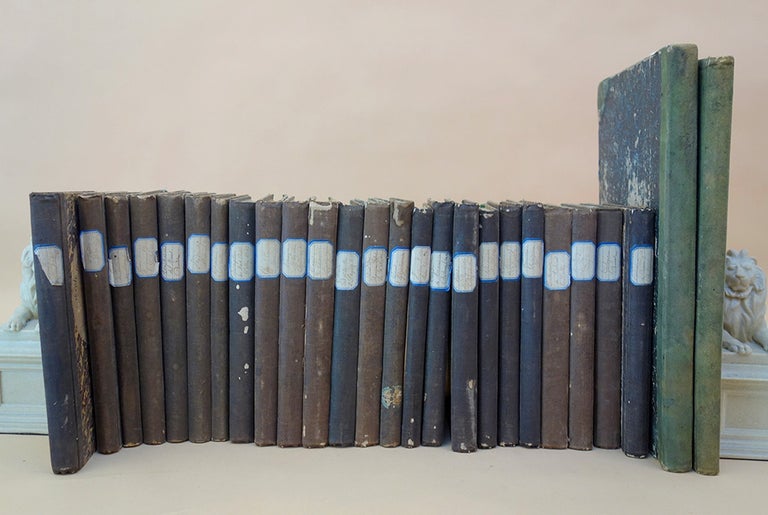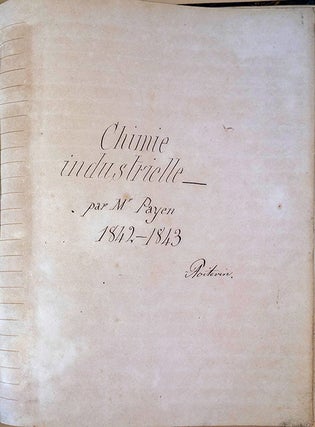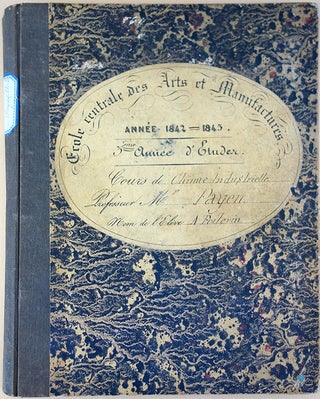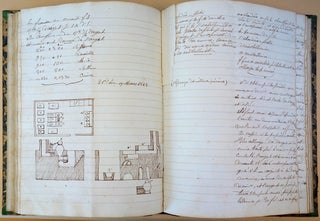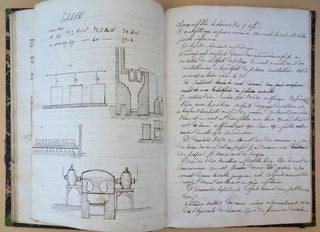24 notebooks plus 2 ledgers relating to his scientific education at l'Ecole Centrale
Publisher Information: 1840-43.
Poitevin, Alphonse (1819-82). Archive consisting of 24 autograph signed manuscript notebooks from Poitevin’s student days at the École Centrale des Arts et Manufactures and 2 ledgers documenting Poitevin’s business and other expenses in later years. Together 26 volumes, containing over 7000 pages total. 1841-43 and 1856-94. Notebooks measure 217 x 178 mm.; ledgers measure 350 x 227 mm. Original uniform quarter cloth, marbled boards, paper labels on front covers completed in manuscript by Poitevin (notebooks); original half suede, marbled boards (ledgers). Some wear and rubbing especially to ledger volumes, some dampstaining in ledger volumes, but overall very good.
Exceptional archive documenting the scientific education of industrial chemist and photography pioneer Alphonse Poitevin, who was the first to successfully exploit the light-sensitive properties of dichromated gelatin; his work forms the foundation of photolithography, carbon printing and collotype printing. Poitevin’s interest in photography began during his student years at the École Centrale des Arts et Manufactures, when he first began experimenting with Daguerre’s newly introduced photographic process. Our archive of his student notebooks from that period, held privately until recently by Poitevin’s descendants, provides unique access to this important formative stage in his scientific career.
"[Poitevin] took up the study of photography while still a student in the École Centrale, almost immediately after Daguerre’s process was published in 1839. He recognized the one great defect of this method is that it gives but a single photograph. He tried to solve that problem by trying to make molds by electrically depositing copper upon the silver plate carrying the daguerrean image . . . In 1847 when working at the Eastern Salt Works he continued his work on trying to make copies of daguerreotypes on silvered copper . . . Experience from this early work led him to his most important discovery, the photographic engraving technique, which happened in 1854.
". . . In August 1855 he patented a helioplastic process, by which films of dichromated gelatin were exposed to light under a negative and then soaked in water, which resulted in a relief image from which a mold could be made. Mungo Ponton in Scotland had discovered in 1839 the effect of light on dichromates and William Henry Fox Talbot had in 1853 discovered that dichromated gelatin which had been exposed to light would allow greasy ink to adhere to it, although it repelled water. Based upon these facts Poitevin invented his new photo-lithographic processes: carbon printing and collotype printing [emphasis ours] . . . For the discovery of the permanent photographic printing process he was awarded the Duc de Luyne’s Prize of 20,000 francs and the Marquis of Argentil’s Prize of 12,000 francs as well as the order of Chevalier of the Légion d’Honneur (Encyclopedia of Nineteenth-Century Photography, pp. 1139-40)."
During his time at the École Centrale, Poitevin studied under a number of distinguished professors including the following:
• Chemist and physicist Henri-Victor Regnault (1810-78), founder of the Société Française de Photographie and one of the first to use and promote photography on paper
• Industrial chemist Anselme Payen (1795-1871), the first to isolate cellulose, which rapidly led to the development of the wet collodion process in photography
• Chemist Eugène Péligot (1811-90), who isolated the first sample of pure uranium metal and also discovered potassium chlorochromate, a salt made from the photosensitive chemical potassium dichromate
• Physicist Jean Claude Eugène Péclet (1793-1857), for whom the Péclet number, used in fluid mechanics, is named
• Zoologist Henri Milne-Edwards (1800-1885), professor of entomology at the Muséum Nationale d’Histoire Naturelle and author of several
important works on natural history Our archive contains Poitevin’s notebooks for the classes he took from these four men as well as for eighteen other courses. A complete list of the notebooks, arranged by academic year, follows:
1840-41
Géometrie analytique, M. Martelet
Géometrie descriptive, M. Olivier (2 vols.)
Méchanique, M. Belanger
Histoire naturelle, M. Edwards
Physique, M. Regnault
Chimie, M. Péligot (2 vols.)
1841-42
Chimie industrielle, M. Payen
Chimie analytique, M. Dumas
Géologie, M. Burat
Mécanique appliquée, M. Belanger
Physique industrielle, M. Péclet
Métallurgie du fer [metallurgy of iron], M. Ferry
Construction des machines, M. Walter
Constructions, M. Mary
1842-43
Exploitation des mines, M. Burat
Machines-outils [machine tools], M. Walter de St. Ange
Métallurgie de la fonte [metallurgy of cast iron]
Physique appliquée, M. Péclet
Hydraulique, M. Belanger
Chimie industrielle, M. Payen
Machines à vapeur [steam engines], M. Thomas
Travaux publiques [public works], M. Mary
The archive also includes two ledger volumes documenting Poitevin’s income and expenses beginning in 1856, when he resigned from the Eastern Salt Works to form his own photolithographic printing company. The business failed after about a year, and Poitevin was forced to sell his patent rights to French lithographer Alfred-Léon Lemercier. Afterwards Poitevin worked as an industrial chemist for several French firms while pursuing his researches into photographic printing processes; some of the expenses related to these investigations may be recorded in the ledgers. The ledger entries continue until the mid-1890s, over a decade after Poitevin’s death; it is likely that Poitevin’s family continued to use the ledgers to document their finances.
Book Id: 44568Price: $15,000.00

